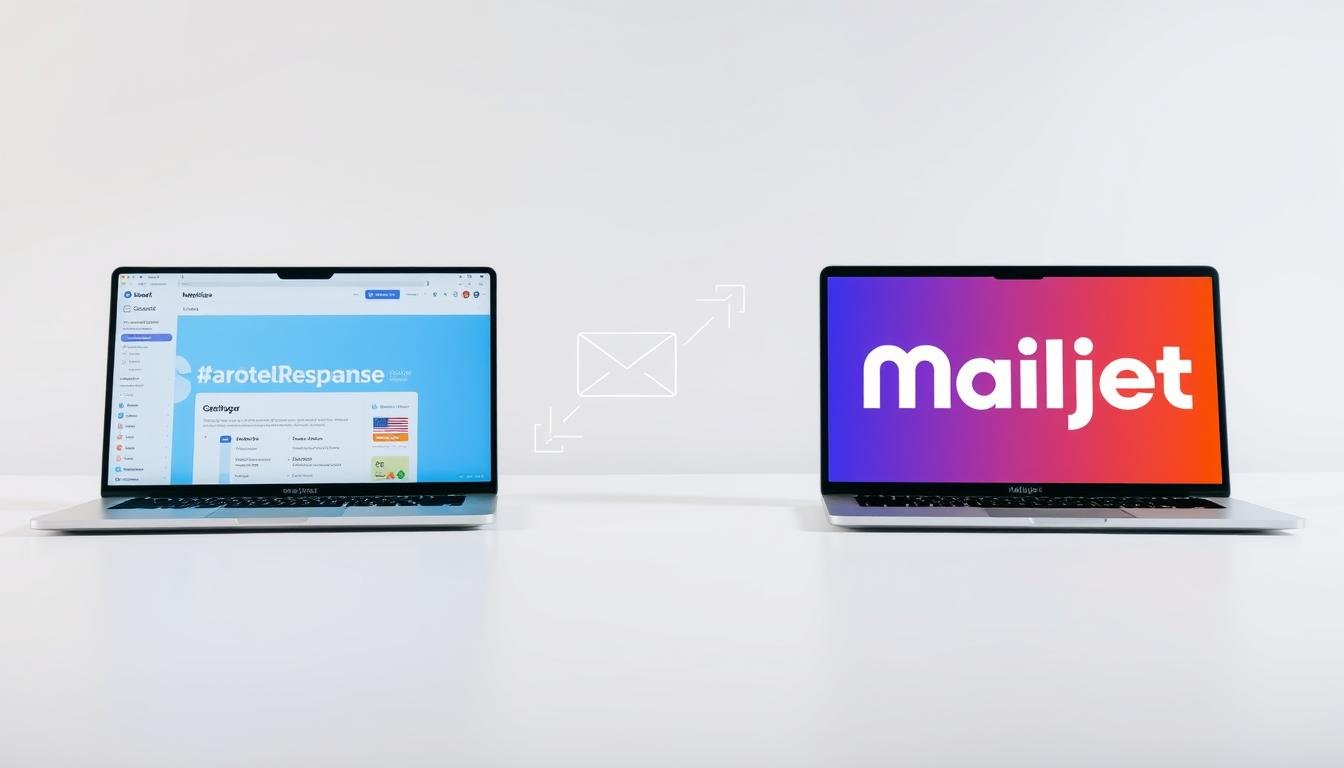Which platform actually gets time-sensitive messages into the inbox when it matters most?
You need clear data if your website, product, or app depends on reliable delivery. This comparison focuses on what matters for transactional email: deliverability, integration paths, and total cost. By prioritizing these elements, you can ensure a seamless experience for your users and maintain their trust. To enhance your email marketing strategy further, explore the getresponse transactional email features that offer automation and customization options to optimize your outreach. Ultimately, choosing the right platform can significantly impact your engagement and conversion rates.
Mailjet combines newsletter tools with transactional functionality and lists pricing like 15,000 emails for $17/month and EU data hosting. That gives an idea of price and scale you can expect.
On the other hand, an established email marketing suite may offer broad features that help with marketing flows but add complexity to sending simple email notifications.
Throughout this guide you’ll see Glockapps delivery averages, plan limits, and practical feature comparisons that help you choose the right email service for your users and your business needs.
Key Takeaways
- Compare deliverability numbers and variance, not just averages.
- Match API and SMTP features to your integration needs.
- Estimate total monthly cost using your actual send volume.
- Choose EU hosting if data residency matters to your users.
- Weigh marketing suite convenience against hybrid service simplicity.
Why transactional email services matter right now
Reliable delivery of time‑sensitive messages is suddenly non‑negotiable for online businesses. If your website relies on alerts or confirmations, a delayed or blocked message damages trust and revenue.
Many web hosts enforce strict sending limits. For example, IONOS caps bursts (30 emails in 5 minutes). That constraint can interrupt sending and push critical mail into spam.
Real‑world tests using Mail‑Tester and Glockapps show mail sent through generic servers often fails inbox placement. Specialized email services improve delivery and reduce throttling under load.
- What counts as transactional: password resets, order confirmations, invoices, shipping notices, event reminders, support follow-ups, and system alerts.
- What to look for: proven delivery rates, strict domain authentication, predictable pricing, and tools to test inbox placement across providers.
- Why it matters: the right service protects your domain reputation and keeps mission‑critical messages arriving on time.
getresponse vs mailjet for transactional emails: quick context
Decide whether your priority is advanced campaign automation or a single account that serves production messages and newsletters. This choice drives architecture, team handoffs, and long-term cost.
EmailToolTester labels one platform as a marketing-first email service and the other as a hybrid that blends newsletter editing with transactional email functionality. The hybrid packs an editor, templates, SMTP and an API into the same plan.
That matters if your marketers must own templates while developers trigger sends from the web backend. A single UI reduces friction and tool sprawl.
- Marketing suite: deep campaign tools and automation, suited when advanced flows matter.
- Hybrid provider: consolidates newsletter work and production mail in one simple email service.
- Cost and trial: the hybrid offers a free plan (6,000 per month, 200 per day) and clear steps at 15k, 50k, 100k sends — useful to pilot volume before commit.
Quick takeaway: pick the marketing software if campaigns drive your roadmap. Choose the hybrid if you want one account that covers marketing and transactional email needs with minimal handoffs.
Deliverability and inbox placement performance
Inbox placement determines whether a time-sensitive message helps or harms your user experience.
Real test results matter. In two Glockapps rounds the vendor averaged about 85% deliverability. Results varied across runs (84%, 92%, 72%, 92%), which shows some mailbox networks accept more mail than others.
Shared IP pools lower cost but can cause reputation swings. Dedicated IPs reduce noisy neighbors and are worth it when high volume or critical alerts are on the line. Authenticate your sending domain with SPF, DKIM, and DMARC to protect your sender address and improve delivery.
How testing tools guide decisions
Glockapps-style test runs simulate placement across major providers. Use regular tests to spot spam folder trends, tune sending cadence, and validate authentication.
| Factor | Impact | Action |
|---|---|---|
| Deliverability score | High = inbox; Low = spam | Run recurring tests and adjust content |
| IP type | Shared vs dedicated reputation | Upgrade to dedicated at scale |
| Authentication | Domain alignment protects address | Enforce SPF, DKIM, DMARC |
| Transport | SMTP vs API control | Use API for webhooks and better tracking |
Operational tip: warm up new domains and monitor metrics each month. Tie alerts to spikes in bounces or spam so you can act before large portions of your email volume are affected.
Setup experience, SMTP relay, and email API integration
How you connect your app or website determines control, visibility, and how quickly you can recover from delivery problems.
SMTP vs API: reliability, speed, and developer control
SMTP is quick to set up and gets mail out fast. Use it when you need to send emails immediately and change little about payloads.
API gives better analytics, webhooks, and variable handling. An email api is the right choice when you need structured data and eventing.
Connecting websites, WordPress, and plugins
Switching a WordPress plugin from a host gateway to a transactional SMTP relay or an API endpoint often improves delivery and removes throttles.
Template handling, dynamic data, and personalization
- Pass order items and reset links via API for clean templates.
- Keep templates versioned and named like software artifacts.
- Map events—signup, reset, order—so your system sends the correct message and avoids duplicates.
| Integration | Speed | Control | Use case |
|---|---|---|---|
| SMTP relay | Fast | Basic | Simple notifications, quick fixes |
| REST API | Moderate | High | Analytics, webhooks, dynamic templates |
| Plugin (WP) | Fast | Varies | CMS sends via relay or API |
Checklist: verify domain, add SPF/DKIM (and DMARC), insert credentials or keys, then test end‑to‑end with content and tracking enabled. Good support and docs will shorten the learning curve and keep your month of rollout predictable.
Pricing, free plans, and how providers charge per email
How a provider prices volume shapes operational risk and forecasting. Choose plans with predictable step-ups so you can model month-to-month spend.
Free plan guardrails often include daily or hourly caps that protect shared infrastructure but limit production use. For example, a common free plan offers 6,000 emails/month with a 200/day cap. That is fine for tests or pilots but will block steady production sends during growth.
Other services impose hourly limits (some as low as 25/hour). If your app must send bursts—password resets or order batches—those caps can delay delivery and harm UX. Confirm whether support can lift caps quickly during a launch.
Monthly tiers, overage fees, and scaling
Predictable tiers simplify budgeting. Price thresholds often look like 15k at $17/month, 50k at $37/month, and 100k at $105/month. Overage is usually charged per 1,000 extra emails, so estimate peak month volume before choosing a plan.
| Tier | Monthly sends | Typical price (USD) | Notes |
|---|---|---|---|
| Free | 6,000 | $0 | 200/day cap; good for testing flows |
| Entry | 15,000 | $17/month | Predictable monthly cost |
| Growth | 50,000 | $37/month | Suits expanding apps; consider dedicated IP |
| Scale | 100,000 | $105/month | Lower per-email price; add-ons may apply |
- Verify whether a domain needs a paid dedicated IP at scale and include that cost in projections.
- Use staging with the same caps to test end-to-end without getting false confidence from a developer-only plan.
- Document thresholds and approval paths so finance and engineering act quickly when you must move plans.
Security, privacy, and data handling practices

Protecting customer messages starts with how a provider encrypts data and controls mailbox access. Verify transport and storage safeguards before you route production mail through any email service.
Encryption in transit (TLS) and at rest (AES-256)—why it matters
TLS protects messages while they move between systems. AES-256 at rest shields stored content and metadata from unauthorized reads. Prefer providers that combine both and publish their key management practices.
Mailbox and storage models
Some vendors use per-user mailboxes encrypted with user passwords and operate mail in-memory on connection. That design avoids shared databases and reduces multitenant exposure.
- Default storage: 10 GB; expansion in 10 GB blocks at $3 per month shared across domains and aliases.
- Export, backup, and delete options let you manage retention and lower risk when messages include PII.
- Confirm role-based access, audit trails, and who can access email content or system logs.
Prioritize TLS + AES-256 for transactional workflows with customer data. Also check hosting location for compliance, sanitize webhook payloads, and prepare a simple incident plan to revoke keys and re-verify domains quickly.
Compliance, data residency, and domain reputation
Compliance decisions shape technical controls and trust. Choose where message content and logs live before you launch production sending. That reduces surprises during audits and simplifies legal reviews.
EU hosting options and GDPR implications
If you serve European customers, regional hosting matters. An email service that stores customer data inside EU countries helps you meet GDPR expectations and eases standard contractual clause reviews.
Document where emails and logs are stored, who has access, and how long records persist. This step protects your domain reputation by aligning legal and technical controls.
- Map lawful bases: separate required transactional messages from marketing sends so preference management never blocks critical notices.
- Segment by domain: use distinct domains or subdomains to localize routing and simplify audits across regions.
- Contract controls: name data center regions, define incident SLA, and limit support team access in addenda.
| Risk Area | Action | Benefit |
|---|---|---|
| Data residency | Choose EU hosting where customers live | Lower GDPR complexity and audit friction |
| Retention | Set short retention for sensitive logs; enable exports | Reduce breach risk while preserving evidence |
| Domain reputation | Authenticate sending; keep volumes steady | Fewer spam filters and higher inbox rates |
| Access control | Limit support/engineering access and log actions | Clear accountability during incidents |
Build a month-end compliance review into your ops calendar. Small, regular checks catch provider changes that could alter where and how your emails are handled.
Automation features, marketing add‑ons, and ecosystem fit

Combine or specialize: choose a path that matches your team and scale. A hybrid platform that hosts marketing and production sends on one database reduces friction and speeds rollout.
Using one database for marketing + transactional vs specialized tools
EmailToolTester groups providers into three types: newsletter suites, dedicated transactional email services, and hybrids that blend both. Each has clear tradeoffs.
- Hybrid pros: shared templates, unified analytics, and less governance overhead help marketing move fast without developer tickets.
- Suite + specialist: use deep marketing automation with a dedicated relay when deliverability and throughput are critical.
- Operational tip: start on a hybrid plan to iterate fast, then migrate to specialized software if you need dedicated IPs or stricter compliance.
- Don’t forget: segment traffic correctly so marketing sends do not harm transactional deliverability, and validate webhooks and export features for clean CRM pipelines.
Bottom line: pick the approach that minimizes ops friction while meeting your governance, performance, and customer needs.
Support, uptime, analytics, and deliverability tooling
Fast, reliable support and clear monitoring tools are the last mile between setup and consistent inbox placement. You want a provider that answers quickly and gives clear steps during onboarding. That speeds time to the first successful email.
What to expect from chat support, approvals, and monitoring
Responsive chat can remove setup roadblocks. Many services offer live chat that resolves DNS, SPF/DKIM, and API key issues in minutes. When setups are more involved, proactive support shortens your rollout by handling edge cases.
Some providers require approval workflows: account vetting, domain verification, or use-case review. Plan a lead time before launch and document required artifacts so approvals do not delay your month of high-volume sends.
- Run recurring deliverability tests (Glockapps-style) to track inbox placement and spot drift before users notice failures.
- Use alerts tied to soft-bounce spikes, sudden blocks, or spam-foldering so your team can act fast.
- Check analytics scope: simple delivery metrics are common; advanced validation and event exports may sit behind higher plans.
| Area | What to expect | Action |
|---|---|---|
| Support | Live chat + ticketing | Create a playbook and escalation path |
| Monitoring | Delivery reports, test runs | Schedule weekly tests and alerts |
| Access | Role-based controls | Limit admin rights and grant view/send roles |
Build a support playbook with required logs and reproducible test cases so provider teams can prioritize your incidents. Also review uptime SLAs and maintenance windows. For critical transactional flows, consider a failover plan or a staged redundancy to keep users covered while providers maintain systems.
For a real-world user perspective on setup and support experiences, read an independent review that covers chat support and community feedback: real-world review and discussion. Additionally, many users appreciate the platform’s ability to integrate various tools for seamless email marketing. For those looking to enhance their online presence, exploring home design tips and ideas can also complement marketing efforts and attract a wider audience. Engaging with the community can provide valuable insights into both marketing strategies and creative inspiration for projects.
Conclusion
Conclusion
Pick a service that keeps critical messages flowing during spikes and avoids hidden caps that harm user experience.
Choose a simple email service that matches your volume and governance. Mailjet’s hybrid model gives EU hosting, an editor, a 6,000/month free plan (200/day), and clear tiers at 15k/$17, 50k/$37, 100k/$105 with ~85% Glockapps delivery on average.
Map sends, templates, and whether you need an email API or SMTP fallback. Budget for plan upgrades, storage add‑ons ($3/10 GB/month), and possible charge per 1,000 overage so your website can scale without surprises.
Next step: pick the plan that reduces ops friction now, secures your domain and delivery, and gives the features and support you’ll need next month.

